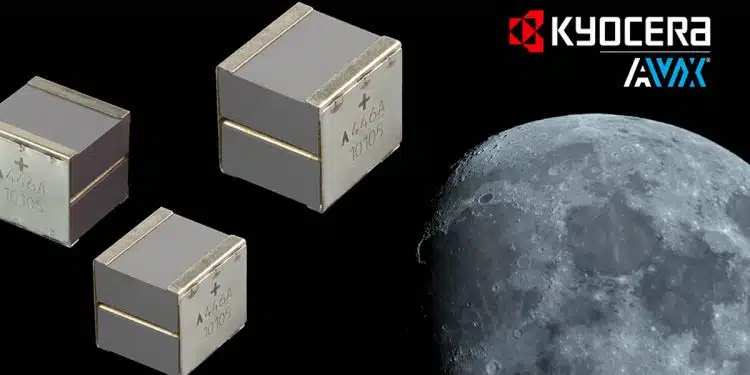KYOCERA AVX contributed several components to the Pragyaan lunar rover, including stacked TCH Series surface-mount tantalum capacitors that became the first polymer capacitors to ever be used in a space mission.
KYOCERA AVX, a leading global manufacturer of advanced electronic components engineered to accelerate technological innovation and build a better future, is proud to announce that it provided several key components for the Indian Space Research Organization’s (ISRO’s) historic Chandrayaan-3 lunar mission.
On August 23, 2023, the Chandrayaan-3 mission’s Vikram lander cemented India’s status as the first country to soft-land a spacecraft near the South Pole of the Moon and the fourth to successfully achieve a lunar landing. The lander also deployed the ISRO’s Pragyaan lunar rover and joined in its mission to study the Moon’s geology, assess its potential water resources, and evaluate its suitability for future human exploration.
KYOCERA AVX contributed several components to the Pragyaan lunar rover, including stacked TCH Series surface-mount tantalum polymer capacitors that were especially designed to suit ISRO specifications, miniature CWR15 MIL-PRF-55365 / 12 tantalum chip capacitors engineered to downsize military and aerospace circuits, high-capacitance and low-ESR TES Series ESCC QPL tantalum chip capacitors, space-level TAZ Series/CWR29 MIL-PRF-55365/11 molded tantalum chip capacitors, and high-reliability MLCCs and EMI feedthrough filters.
KYOCERA AVX began developing the stacked TCH (TCHS) Series surface-mount tantalum polymer capacitors to ISRO specifications back in 2015 and released the series 2016. The TCHS Series is based on the same high-voltage, low-ESR design as its high-reliability TCH Series capacitors. Both have a hermetically sealed ceramic case equipped with conductive polymer electrodes, but the TCHS Series delivers the 44µF/100V capability the ISRO required by stacking two 22µF/100V parts to achieve high-CV performance in the same footprint as single-layer devices. It also exhibits the same stability, reliability, and low leakage as the standard TCH Series but with remarkably low ESR values.
The TCHS Series capacitors designed for use in the Pragyaan lunar rover are rated for use in operating temperatures extending from -55°C to +125°C and exhibit excellent stability in ambient atmosphere environments. They also have the highest voltage rating of any space-grade polymer capacitor available on the market, which makes them ideal for power supplies and hold-up, power filtration, and pulse power circuits in aerospace, defense, and other high-reliability applications with high-capacitance, low-ESR, long-lifetime requirements.
To ensure suitability in high-reliability applications, TCHS Series capacitors are screened using KYOCERA AVX’s patented Q-Process, which effectively eliminates components with operational instability or excessive parametric shifts, and in the midst of the ESA and NASA qualification process. The series is also available with surge current testing and other testing based on high-reliability ESA, NASA, and MIL screening requirements.
Before the TCHS Series capacitors were deployed in the Pragyaan lunar rover, they were used in several other space projects to prove their ruggedness, reliability, and performance.
Most of the 44 TCHS Series capacitors used in the ISRO’s Pragyaan lunar rover were integrated into the power card to help warm the electronics box with energy supplied by the equipped solar panel. This was vital to mission success since the electronics box contains the instruments designed to analyze the chemical composition of the lunar surface, examine the lunar soil and rocks, measure the ions, electron density, and thermal properties of the lunar surface near the South Pole, and transmit solar power to the rover wheels.
“We’re extremely proud to be a small part of the Indian Space Research Organization’s historic Chandrayaan-3 lunar mission,” said Allen Mayar, Global Product Manager – Electrolytic Capacitors, KYOCERA AVX. “Developing space-grade components proven to satisfy challenging application, reliability, and regulatory requirements is a feat of engineering, so we are very proud to see our stacked TCH products fulfill their first critical mission.”
Mayar continued, “KYOCERA AVX has a well-established history of developing electronic components proven to satisfy the highest quality and reliability standards of a range of critical missions and applications. Now that our space-level stacked TCH Series capacitors have proven themselves in the Pragyaan lunar rover, we’re discussing future missions with the ISRO and other global space organizations and looking forward to continuing our proud tradition.”
































